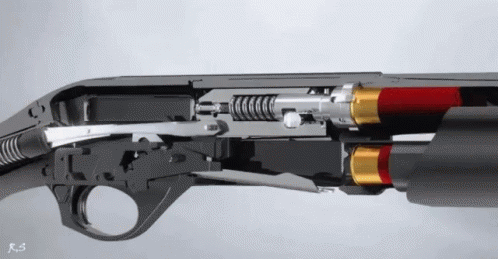Top 4 Shotgun Myths
"[if] you want to keep someone away from your house, just fire the shotgun through the door." – Joe ‘Bad Advice’ Biden
There are a lot of myths and assumptions about shotguns. They impress novice shooters with their power and versatility. But these weapons require a great deal of discipline, care, and training to use. Those users who dedicate a lot of practice and training to the platform can truly appreciate how the shotgun dominates close-range combat.
Myth 1) I don’t need to aim.
Shotguns are more forgiving of hasty aiming, but not a cure-all for bad fundamentals. Having two hands with a good sighting system makes them much more stable than a handgun. The spread of pellets from a shotgun forms a cone, and that cone grows wider at longer ranges. Wider spreads make for a more forgiving target zone, but the shot concentration goes down considerably. This not only reduces the number of hits on the target; it also jeopardizes the safety of non-combatants behind it. As gun owners we are legally and ethically accountable for every round fired. It is reckless and irresponsible to discharge a shotgun with an unpredictable shot spread, or to take a 40 yard shot with a load that is flying wide at 20’.
This image is an approximation that should not be taken as gospel load data. Calculating pattern density follows the ‘Inverse Square Law’.
The best practice is to spend time at the shooting range finding the right combination of shot, barrel, and choke for your needs. You must come to a realistic decision about your need and ability to run slugs through your setup. If the longest shot in your home is 40’, then a configuration that delivers 100% of pellets on torso-sized target is at the ideal range. Slugs should be reserved for longer shots that require precision. Federal Flite-Control is considered the gold standard for tight patterning, but no two guns are exactly alike.
Myth 2) Shotguns are more reliable.
The manual shotguns (pump and lever) are simple machines but extremely sensitive to user error. It seems easy to run them in relaxed environments but running a pump shotgun on a timer is a much more difficult exercise. When these shotguns do jam up it tends to be a serious stoppage that can take you out of the fight entirely. Learning to do corrective action is absolutely critical before you can rely on it for personal defense. Some guns, like the Kel-Tec KSG, are notorious for having fight-stopping jams.
An example of a semiauto shotgun functioning.
Semiautomatic shotguns perform more reliably but at a steep cost, with a reliable and well-proven action costing 2-3x that of a manual shotgun. Many such shotguns are configured for heavy hunting loads rather than lighter personal defense rounds. You may need to take a shotgun to a capable gunsmith to have it tuned for more reliability. These are more complex mechanisms and are less tolerant of neglect than pump guns.
The old stand-by for a working pump shotgun is a Remington 870. Police trade-ins are cheap and easy to get and it is a great starter gun at an affordable price. Older Mossberg 500 series are excellent but I would avoid their new productions, as they are having serious QA/QC issues lately. For semi-automatic guns, the Mossberg 930 is a reasonably-priced gun with good reliability and lots of aftermarket support. Of course, the gold standard for semi-auto shotguns is the Benelli M4 or the Beretta 1301. However you will pay a premium price for these platforms.
Myth 3) Anyone can run a shotgun
Learning how to deal with recoil takes time and professional coaching. Good technique has a significant impact on the shooter’s ability to handle their weapon consistently. Bad technique makes a painful shooting experience. ‘Recoil flinch’ is a very real autonomic nervous response and has ruined a lot of potential shooters over the years. A single painful incident can create a lifetime of problems for a shooter.
Pranking someone with a hard-recoiling gun they are not ready for is a fast way to create a lifetime of fear and bad shooting habits. A shooter won’t run a gun well without practice, and they won’t practice if it is painful to train on the gun. Never give someone a gun they are not ready or able to handle without harming themselves.
Myth 4) Hunting loads work for self-defense purposes.
All loads are not created equal. If you want the short and simple answer for home defense: #4 buckshot. Copper is perhaps a slightly better performer than lead (and if you are practicing on public lands, more environmentally friendly).
Why not use other loads?
Birdshot is largely inadequate for personal defense. This is not to say ‘it cannot be lethal’, but ‘lethal in 5-10 minutes’ is not good enough. Using birdshot effectively requires making a near-contact shot. We have spent ten thousand years mastering the art of getting away from enemies and a good marksman’s best advantage in a fight is distance. Throwing that advantage away is a very risky bet to make.
Exotic loads tend to behave unpredictably. Marketing has tried and failed to get people to use discs, pucks, caltrops, flechettes, and all other kind of projectiles. We have found that almost universally these alternate rounds simply don’t perform reliably in terms of flight characteristics or terminal performance. Ballistics tests show that pellets give the most predictable performance.
The old standby of #00 buck (double-aught buck) is a military round that is hugely overkill for self-defense use. So are slugs, which are meant for taking large game at short ranges. #00 buck carries 8 or 9 pellets of .32” each, and every pellet contains enough energy to go clear through a target and multiple barriers behind it. It was designed to clear trenches stacked with soldiers, not for conscientious home defense. By switching to a smaller shot like #1 Buck a shooter gains 30% more total pellet surface area for wounding without sacrificing any lethality. It is still very energetic so I prefer #4 except if you’re LEO/MIL and concerned with intermediate barriers as a regular challenge. #4 performs extremely well in gel tests, consistently hitting the FBI ideal of 12-18” of penetration. The increased number of pellets makes a fight-stopping hit much more likely as well. This is as light as you should go for a home defense load.
(Sidebar: I am a big fan of the Aguila mini-shells. They have 50% of the payload but offer significantly reduced recoil and much higher capacity. However, only a few shotguns can run these reliably).
~~
Fortunately all these drawbacks and hurdles can be overcome, with time, practice, research, and training. In the right hands the shotgun is a tremendously versatile weapon. It punishes people who see it as a shortcut to skill, and rewards shooters committed to mastering the platform. There is simply nothing on par with a shotgun when it comes to rapidly putting down combative targets.






